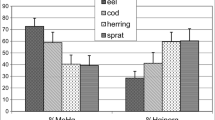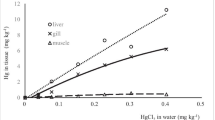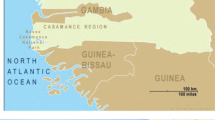Abstract
Carcinus maenas is an invasive species of recognised economical and ecological importance in which mercury accumulation could be a pathway for bioamplification through food webs. Little information is available about differential accumulation between crab sexes and morphotypes. Taking this in mind, a set of different industrial discharge scenarios were investigated in 96-h laboratory experiments for assessing the accumulation of inorganic mercury from contaminated seawater into the tissues of C. maenas. Three groups of crabs (green males, green and red females) where exposed to 5, 50 and 250 μg Hg L−1. Differences among sexes, morphotypes and tissues were detected, depending on the mercury concentration. The muscle did not show differential accumulation between sexes or morphotypes. For mercury-exposed crabs, the contaminant was accumulated preferably in the gills (more than 75%) while, in control experiments, it was in the internal organs, muscle and hepatopancreas, and gills corresponded to less than 31% of the total mercury quantified. The different tissue contamination seems dependent on the major pathway of exposure, diet or water. Mercury accumulation by the crab was a rapid process and could represent a risk for the environment only after 96 h. In a scenario of a discharge point of 250 μg L−1, all tissues of crabs exposed would attain a very close, or even exceed the threshold concentration value for human consumption (0.5 mg kg−1).


Similar content being viewed by others
References
Abelló, P., Aagaard, A., Warman, C. G., & Depledge, M. H. (1997). Spatial variability in the population structure of the shore crab Carcinus maenas (Crustacea: Brachyura) in a shallow-water, weakly tidal fjord. Marine Ecology Progress Series, 147, 97–103.
Andres, S., Laporte, J. M., & Mason, R. P. (2002). Mercury accumulation and flux across the gills and the intestine of the blue crab (Callinectes sapidus). Aquatic Toxicology, 56, 303–320.
Baeta, A., Cabral, H. N., Neto, J. M., Marques, J. C., & Pardal, M. A. (2005). Biology, population dynamics and secondary production of the green crab Carcinus maenas (L.) in a temperate estuary. Estuarine Coastal and Shelf Science, 65, 43–52.
Bamber, S. D., & Depledge, M. H. (1997). Responses of shore crabs to physiological challenges following exposure to selected environmental contaminants. Aquatic Toxicology, 40, 79–92.
Bjerregaard, P. (1990). Influence of physiological condition on cadmium transport from haemolymph to hepatopancreas in Carcinus maenas. Marine Biology, 106, 199–209.
Bjerregaard, P. (1991). Relationship between physiological condition and cadmium accumulation in Carcinus maenas (L.). Comparative Biochemistry and Physiology A, 99, 75–83.
Bjerregaard, P., & Christensen, L. (1993). Accumulation of organic and inorganic mercury from food in the tissues of Carcinus maenas: Effect of waterborne selenium. Marine Ecology Progress Series, 99, 271–281.
Bondgaard, M., Nørum, U., & Bjerregaard, P. (2000). Cadmium accumulation in the female shore crab Carcinus maenas during the moult cycle and ovarian maturation. Marine Biology, 137, 995–1004.
Bowen, H. J. M. (1966). Trace metals in biochemistry. London: Academic.
Bryan, G. W. (1964). Zinc regulation in the lobster Homarus vulgaris. I. Tissue zinc and copper concentrations. Journal of the Marine Biological Association of the United Kingdom, 44, 549–563.
Bryan, G. W. (1971). The effects of heavy metals (other than mercury) on marine and estuarine organisms. Proceedings of the Royal Society B, 177, 389–410.
Calderón, J., Ortiz-Pérez, D., Yáñez, L., & Díaz-Barriga, F. (2003). Human exposure to metals. Pathways of exposure, biomarkers of effect, and host factors. Ecotoxicology and Environmental Safety, 56, 93–103.
Canli, M., & Furness, R. W. (1995). Mercury and cadmium uptake from seawater and from food by the norway lobster Nephrops norvegicus. Environmental Toxicology and Chemistry, 14, 819–828.
Cardoso, P. G., Lillebø, A. I., Pereira, E., Duarte, A. C., & Pardal, M. A. (2009). Different mercury bioaccumulation kinetics by two macrobenthic species: The bivalve Scrobicularia plana and the polychaete Hediste diversicolor. Marine Environmental Research, 68, 12–18.
Coelho, J. P., Reis, A. T., Ventura, S., Pereira, M. E., Duarte, A. C., & Pardal, M. A. (2008). Pattern and pathways for mercury lifespan bioaccumulation in Carcinus maenas. Marine Pollution Bulletin, 56, 1104–1110.
Cohen, A. N., Carlton, J. T., & Fountain, M. C. (1995). Introduction, dispersal and potential impacts of the green crab Carcinus maenas in San Francisco Bay, California. Marine Biology, 122, 225–237.
Dam, E., Styrishave, B., Rewitz, K. F., & Andersen, O. (2006). Intermoult duration affects the susceptibility of shore crabs Carcinus maenas (L.) to pyrene and their ability to metabolise it. Aquatic Toxicology, 80, 290–297.
Domouhtsidou, G. P., & Dimitriadis, V. K. (2000). Ultrastructural localization of heavy metals (Hg, Ag, Ph, and Cu) in gills and digestive gland of mussels, Mytilus galloprovincialis (L.). Archives of Environmental Contamination and Toxicology, 38, 472–478.
Evans, D. W., Kathman, R. D., & Walker, W. W. (2000). Trophic accumulation and depuration of mercury by blue crabs (Callinectes sapidus) and pink shrimp (Penaeus duorarum). Marine Environmental Research, 49, 419–434.
Grosholz, E. D., & Ruiz, G. M. (1995). Spread and potential impact of the recently introduced European green crab, Carcinus maenas, in central California. Marine Biology, 122, 239–247.
Horvat, M. (2005). Determination of mercury and its compounds in water, sediment, soil and biological samples. Chap. 8. In N. Pirrone & K. R. Mahaffey (Eds.), Dynamics of mercury pollution on regional and global scales: Atmospheric processes and human exposure around the world (pp. 153–190). USA: Springer.
Inza, B., Ribeyre, F., & Boudou, A. (1998). Dynamics of cadmium and mercury compounds (inorganic mercury or methylmercury): Uptake and depuration in Corbicula fluminea. Effects of temperature and pH. Aquatic Toxicology, 43, 273–285.
Laporte, J. M., Truchot, J. P., Ribeyre, F., & Boudou, A. (1997). Combined effects of water pH and salinity on the bioaccumulation of inorganic mercury and methylmercury in the shore crab Carcinus maenas. Marine Pollution Bulletin, 34, 880–893.
Laporte, J. M., Andres, S., & Mason, R. P. (2002a). Effect of ligands and other metals on the uptake of mercury and methylmercury across the gills and the intestine of the blue crab (Callinectes sapidus). Comparative Biochemistry and Physiology. C: Toxicology & Pharmacology, 131, 185–196.
Laporte, J. M., Truchot, J. P., Mesmer-Dudons, N., & Boudou, A. (2002b). Bioaccumulation of inorganic and methylated mercury by the gills of the shore crab Carcinus maenas: Transepithelial fluxes and histochemical localization. Marine Ecology Progress Series, 231, 215–228.
Lawson, N., & Mason, R. (1998). Accumulation of mercury in estuarine food chains. Biogeochemistry, 40, 235–247.
Lee, K. T., McKnight, A., Kellogg, K., & Juanes, F. (2003). Salinity tolerance in color phases of female green crabs, Carcinus maenas (Linnaeus, 1758). Crustaceana, 76, 247–253.
Mason, R. P., Reinfelder, J. R., & Morel, F. M. M. (1996). Uptake, toxicity, and trophic transfer of mercury in a coastal diatom. Environmental Science & Technology, 30(6), 1835–1845.
McGaw, I. J., & Naylor, E. (1992). Salinity preference of the shore crab Carcinus maenas in relation to coloration during intermoult and to prior acclimation. Journal of Experimental Marine Biology and Ecology, 155, 145–159.
McKnight, A., Mathews, L. M., Avery, R., & Lee, K. T. (2000). Distribution is correlated with color phase in green crabs, Carcinus maenas (Linnaeus, 1758) in Southern New England. Crustaceana, 76, 763–768.
Raffaelli, D., Conacher, A., McLachlan, H., & Emes, C. (1989). The role of epibenthic crustacean predators in an estuarine food web. Estuarine, Coastal and Shelf Science, 28, 149–160.
Reid, D. G., Abelló, P., Kaiser, M. J., & Warman, C. G. (1997). Carapace colour, inter-moult duration and the behavioural and physiological ecology of the Shore Crab Carcinus maenas. Estuarine, Coastal and Shelf Science, 44, 203–211.
Rewitz, K., Styrishave, B., & Andersen, O. (2003). CYP330A1 and CYP4C39 enzymes in the shore crab Carcinus maenas: Sequence and expression regulation by ecdysteroids and xenobiotics. Biochemical and Biophysical Research Communications, 310, 252–260.
Soundarapandian, P., Premkumar, T., & Dinakaran, G. K. (2010). Impact of bioaccumulation of mercury in certain tissues of the marine shrimp, Penaeus monodon (Fabricius) from the Uppanar Estuary. Current Research Journal of Biological Sciences, 2(2), 114–117.
Styrishave, B., & Andersen, O. (2000). Seasonal variations in hepatopancreas fatty acid profiles of two colour forms of shore crabs, Carcinus maenas. Marine Biology, 137, 415–422.
Styrishave, B., Faldborg Pertersen, M., & Andersen, O. (2000). Influence of cadmium accumulation and dietary status on fatty acid composition in two colour forms of shore crabs, Carcinus maenas. Marine Biology, 137, 423–433.
Tchounwou, P. B., Ayensu, W. K., Ninashvili, N., & Sutton, D. (2003). Review: Environmental exposure to mercury and its toxicopathologic implications for public health. Environmental Toxicology, 18, 149–175.
Warman, C. G., Reid, D. G., & Naylor, E. (1993). Variation in the tidal migratory behaviour and rhythmic light-responsiveness in the shore crab, Carcinus maenas. Journal of Marine Biology Association of the United Kingdom, 73, 355–364.
Watras, C. J., & Bloom, N. S. (1992). Mercury and methylmercury in individual zooplankton: Implications for bioaccumulation. Limnology and Oceanography, 37, 1313–1318.
Acknowledgements
The present work was supported by FCT (Fundação para a Ciência e Tecnologia) through a PhD grant awarded to Sónia Costa (SFRH/BD/31247/2006) and through the Research Project MERCOAST (PTDC/MAR/101906/2008). The authors are indebted to all colleagues who assisted in the field and laboratory work.
Author information
Authors and Affiliations
Corresponding author
Rights and permissions
About this article
Cite this article
Costa, S., Viegas, I., Pereira, E. et al. Differential Sex, Morphotype and Tissue Accumulation of Mercury in the Crab Carcinus maenas . Water Air Soil Pollut 222, 65–75 (2011). https://doi.org/10.1007/s11270-011-0809-6
Received:
Accepted:
Published:
Issue Date:
DOI: https://doi.org/10.1007/s11270-011-0809-6




